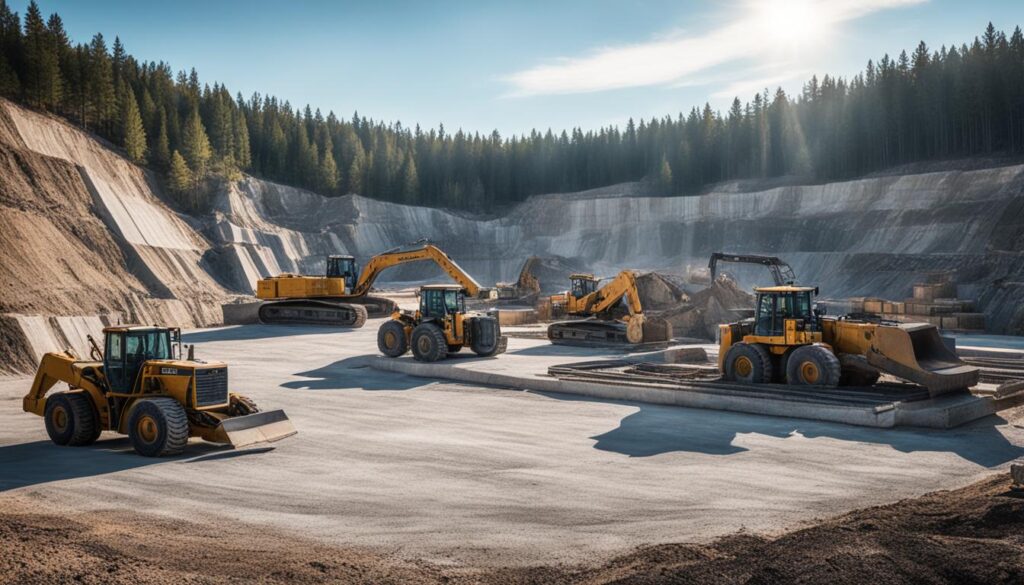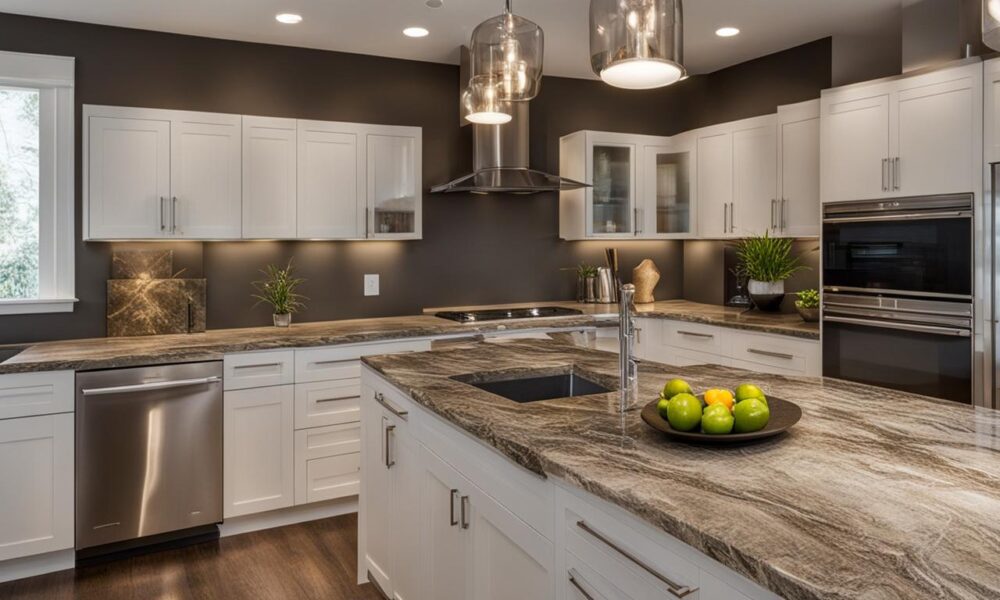Natural Stone Investment: A Cost Analysis for Homes
In the landscape of home improvement investment, the allure and prestige of natural stone continue to weave its timeless narrative. As market analyses anticipate a surging valuation of the natural stone market witnessing an ascent from $35,998.50 million in 2021 to a projected $60,367.30 million by 2030, homeowners and investors alike recognize its unyielding potential for enhancing home value. Reflective of a solid CAGR of 5.0%, these stones not only promise an aesthetic charm one might find in historical epitomes like the Taj Mahal but also offer a smart home improvement investment.
The Asia-Pacific’s remarkable contribution of $19,907.20 million in 2021 suggests an unwavering trend towards the best stone for home value. The region’s forecasted growth to a robust $35,170.00 million by 2030 is a testament to natural stone’s merits. These include its unique character, stability, and the grace it lends to architectural endeavors. Beyond the realm of design, natural stone also contributes to sustainable building practices through its alignment with revered benchmarks like LEED. Notwithstanding maintenance demands inherent in some porous stone types, ongoing breakthroughs in their extraction and preparation continue to enhance their appeal and use in the home improvement investment sphere.
When considering the natural stone cost analysis, it is no surprise that this material stands out as a superior contender. With benefits ranging from its unquestionable durability to environmental friendliness, natural stone not only redefines the aesthetics of living spaces but also fortifies them for generational appreciation.
Key Takeaways
- Rapid growth in the natural stone market indicates a promising future for home improvement investments.
- Natural stone is widely cherished for its unique aesthetic and durability, reinforcing its status as the best stone for home value.
- Positive growth in the Asia-Pacific region reflects strong market confidence and consumer demand for natural stone benefits.
- Technological advancements in fabrication and maintenance mitigate natural stone’s inherent porosity, enhancing its structural reliability.
- Natural stone’s compatibility with LEED demonstrates its environmental advantage and contribution to sustainable building trends.
The Growing Market Value of Natural Stone in Residential Applications
The integration of natural materials into residential spaces epitomizes sophistication, making the global natural stone market an essential component of modern home construction. Forecasted to reach a remarkable value of $60,367.30 million by 2030, the market’s thriving trajectory is supported by a solid annual growth rate, echoing the increasing preference for luxury and quality in residential builds.
Projected Growth of the Global Natural Stone Market
Heeding the call for both aesthetic and durability, the emergence of marble and granite within residential spaces speaks to the enduring nature of these materials. Coupled with a consistent 5.0% CAGR, the market’s expansion reflects a deepening confidence in natural stone which transcends mere decorative purposes to become an inherent aspect of structural value.
Asia-Pacific’s Dominance in Natural Stone Revenue Generation
Asia-Pacific’s impressive natural stone revenue contribution stands at the forefront of this expansion. Notable regions such as China, India, Italy, and Spain serve as pivotal sources of exquisite natural stone, facilitating its ubiquitous presence across a spectrum of residential applications. Prevailing trends in urbanization and smart city developments further propel the market’s vigor in this region.
| Region | 2021 Revenue ($ million) | 2030 Projected Revenue ($ million) | CAGR |
|---|---|---|---|
| Asia-Pacific | 19,907.20 | 35,170.00 | 5.0% |
| Europe | Data Pending | Data Pending | Data Pending |
| North America | Data Pending | Data Pending | Data Pending |
As homeowners continue to opt for residential natural stone applications, it’s clear that the substance of choice is one which promises not only immediate beauty but also a lasting contribution to the property’s natural stone market value. The numbers speak volumes—natural stone is not a mere trend, but a foundational element for residential refinement.
Understanding the Unique Appeal of Natural Stone
The investment in natural stone is deeply intertwined with its timeless aesthetic and inherent design versatility, qualities that have solidified its position as a favorite among homeowners and designers alike. Revered for its natural beauty and diverse application, each piece of natural stone offers a unique expression of earth’s artistry. In turn, this singularity presents an opportunity for property owners to elevate the value and character of their spaces substantially.
Natural stone ROI is a powerful consideration for individuals looking to bolster the long-term value of their properties. Anchoring luxurious elegance while standing as paragons of resilience, materials like granite and sandstone command attention and admiration. Whether featured as sleek marble countertops or rustic limestone flooring, the adaptability of natural stone to various design contexts is unmatched.
Timeless Aesthetic and Design Versatility of Natural Stones
Marble, with its veined patterns and warm tones, is a testament to the timeless aesthetic of natural stone. Its ability to be sculpted, polished, and incorporated across a multitude of environments—from floorings to tabletops—is a testament to its design versatility. Similarly, the rugged texture of sandstone and the polished grandeur of granite can adapt to various design schemas, establishing a distinct aura of sophistication in any application.
Eco-friendly Attributes and Contribution to LEED Certification
In today’s eco-conscious landscape, eco-friendly natural stone emerges as an increasingly coveted resource. The extraction and application of natural stone adhere to environmentally considerate practices more now than ever, with industry advancements minimizing the ecological footprint of this age-old material. Moreover, natural stone’s composition and longevity contribute to sustainable building metrics, allowing projects to accumulate points toward LEED certification. Investing in natural stone not only enhances the aesthetic caliber of a structure but also its ecological integrity, appealing to the burgeoning demographic of environmentally-minded stakeholders.
Cost Analysis: Is Investing in Natural Stone Worth It for Your Home?
When homeowners consider cost-effective home upgrades, an investment in natural stone stands out for its potential to bring about home value appreciation. Among the array of stone options, granite plays a pivotal role due to its enviable blend of durability and aesthetic richness. As individuals mull over whether is investing in natural stone worth it for their home, assessing the financial implications and benefits associated with this sought-after material is essential.
Granite, lauded for its outstanding hardness and heat resistance capabilities, makes an attractive option for high-traffic areas in the home. Kitchen countertops made from this natural stone withstand the test of time and rigors of daily use while maintaining their polished look with minimal effort. Its elegance transcends functionality, presenting homeowners with a palette of colors and textures that blend seamlessly into their living spaces.
Yet, the appeal of granite extends beyond its surface properties. The inherent qualities of this natural stone contribute to a higher market valuation of the property. Reports suggest that the home value appreciation with natural stone such as granite can be significant, turning the initial investment into a long-term advantage for homeowners looking to enhance the marketability of their property.

Moreover, the overall ascent of the natural stone market resonates with its stature as a savvy investment. With the global valuation of the natural stone domain projected to burgeon, the trend underscores the sector’s stability and robust potential for ROI. Both aesthetic enrichment and appreciable returns on investment are, therefore, compelling reasons to consider natural stone as a tangible asset in the realm of residential enhancement.
- Granite’s resilience against wear makes it a prudent choice for homes
- Natural stone’s diverse range of colors and textures ensures a unique, personalized touch
- Investing in natural stone aligns with market trends pointing to increased property valuations
Whether it is to indulge in the luxurious appeal granite brings to a kitchen or to lay a foundation for the future sale of a property, natural stone merits attention. The answer to whether is investing in natural stone worth it for your home leans towards a resounding affirmation when considering the cumulative benefits. With thoughtful selection and proper care, natural stone can be the cornerstone of cost-effective home upgrades that pay dividends in both aesthetics and equity.
Impact of COVID-19 on the Natural Stone Industry
The onset of the COVID-19 pandemic invariably marked a period of unprecedented challenges for the global natural stone industry. Quarry operations, production lines, and supply chains were severely disrupted, echoing a wider halt in industrial activities. This sector, renowned for providing elegant marble, robust granite, and an array of other natural stones, faced a tumultuous demand and logistical tumult. The inevitable downturn not only pressured the market but also foreshadowed a rigorous path to recovery—one that hinged on the industry’s adaptability and resilience.

Pandemic-Induced Operational Challenges and Market Recovery
With safety regulations bringing a sudden pause to essential processes across the quarry-to-market pipeline, the COVID-19 natural stone industry impact was immediate and multifaceted. Lapses in production and delayed projects were commonplace, leading to financial strains and workforce reductions. Key infrastructural projects, such as hospital expansions—vital during a health crisis—struggled to maintain momentum as the accessibility to these crucial building materials dwindled.
The market recovery after COVID-19, while gradual, is a narrative of resolve and strategic maneuvering. Adjustments in operation protocols, implementation of remote work where feasible, and diversification of supply sources emerged as vital aspects of the industry’s response to the market fluctuations caused by the pandemic. These strategic shifts, aimed at resilience, have gradually ushered the natural stone market toward a positive outlook, adapting to the new normal post-COVID era.
Adaptive Measures: Safety Protocols and Resuming of Construction
The industry’s comeback story is underpinned by the adoption of stringent safety protocols in the natural stone industry, essential to re-energizing its workforce and reassuring all stakeholders. The re-initiation of construction activities came with an enhanced awareness of health and safety, encompassing regular health checks, social distancing on sites, and the provision of personal protective equipment (PPE). These measures have not only expedited a return to form but have also instilled a newly fortified sense of operational safety, positioning the industry to meet the eager demands of a recovering market.
In aligning with these elevated standards, the industry has displayed a commendable agility—balancing the revival of commerce with prudent measures to protect the individuals who drive its success. As the world adapts to life alongside and beyond COVID-19, the natural stone industry is set to emerge stronger, poised to meet the evolving needs of construction and design with renewed vigor and assurance.
Comparing Natural Stone with Alternative Building Materials
When venturing into the vast realm of home construction and design materials, a distinct comparison often arises between the natural allure of stone and the practical appeal of alternatives such as ceramic tiles. This juxtaposition not only delves into the aesthetic and tactile qualities of the materials at hand but also weighs the critical facets of maintenance and durability that are paramount in material selection.
Benefits and Limitations of Natural Stone versus Ceramic Tiles
Natural stone, with its myriad of finishes, grades, and natural hues, offers a distinctive character incapable of replication by man-made materials. The natural stone benefits extend far beyond its profound elegance; it’s a symbol of durability and longevity. However, the maintenance of natural stone demands a meticulous approach, including sealing procedures essential for protecting its porous surface from stains and ensuring its continued resilience. Conversely, ceramic tiles present a comparatively low-maintenance alternative. With an expansive variety of designs and the added convenience of glazed protections, ceramic tiles attract homeowners seeking uniformity, ease of installation, and minimal aftercare.
Consumer Preferences: Aesthetic Value versus Maintenance and Durability
In the broader landscape of consumer preferences in building materials, the deliberation between the untouched beauty of natural stone and the practicality of ceramic tiles is profound. While some may gravitate towards the ease and consistency offered by ceramic tiles, others remain steadfast in their appreciation for the unmatched aesthetic value and the intrinsic durability of natural stone. This dichotomy is particularly evident in areas of the home such as kitchen countertops and flooring, where enduring installations are not merely desired but deemed necessary. Thus, maintaining and durability, alongside aesthetic primacy, become critical factors that shape consumer decisions, steering them either towards the authentic charm of natural stone or the functional allure of ceramic tiling.



